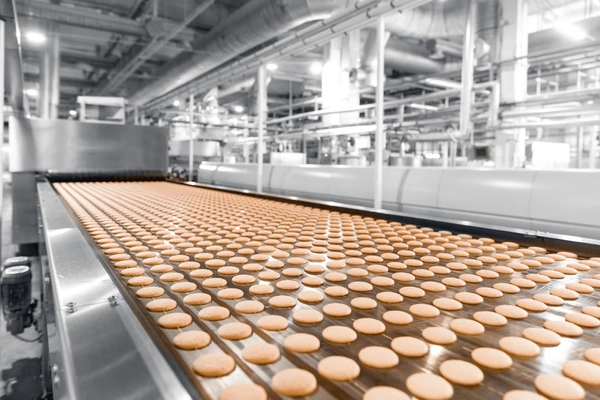
What is a complete biscuit production line?
A modern biscuit production line comprises several interconnected devices that enable the mass production of quality biscuits. These include mixing systems, dough formers, laminators and molders, baking ovens, cooling conveyors, and packaging machines.
The mixing system ensures that the ingredients are fully incorporated to achieve the required dough consistency. Dough formers create the outer shape of the biscuit dough, while laminators and molders work to manufacture layered or specially shaped biscuits.
The required level of evenness and heat efficiency is achieved through baking using a baking oven, which may be a tunnel or rotary type. The cooling conveyor belts first cool the baked biscuits at the appropriate temperature before they are moved for wrapping into final packaging tanks and sealed with automated machines so that they do not lose freshness.
For more in-depth information, you should view the Biscuit Production Line – Loyal
How Automation Enhances Biscuit Manufacturing
Automation has improved efficiency and quality control in biscuit production. Advanced robotics and sensor technologies have enabled tight control across all stages of the production line.
Automation reduces human errors, lowers the cost of labor, and increases the speed of production, which in turn increases the output of quality goods. Automation control strategizes the production to deliver what quantities are needed in real-time, changing the interaction and the response. Automated systems remove hygienic concerns regarding industrial setup and end-product compliance with international hygiene standards.
Various Types of Biscuits That Are Manufactured Using Industrial Lines
Industrial biscuit production lines are built to fulfill the different needs of consumers, ranging from a variety of biscuits to a high production output. For instance, some include standard biscuits such as Marie or digestive biscuits, followed by cream or jam-filled sandwich biscuits, and last but not least, specialty biscuits, which consist of chocolate or nuts.
Switching from one biscuit to another has been made easy due to the advanced line allowing minimal downtime when changing parameters or molds. This quick execution of a change encourages the manufacturers to keep up with the market and expand their selections to grab the consumers’ attention.
How has biscuit machinery evolved for 2024?
State-of-the-Art Features in Biscuit Production Equipment
The biscuit production technology in 2024 has been designed with great features to improve productivity, accuracy, and product quality. Some of the key features include:
- Artificial Intelligence enables predictive maintenance and adaptive control systems that reduce downtime and efficiently utilize resources.
- IoT: Remote adjustment and monitoring can be implemented through IoT, so the collection of relevant data has been made easy and seamless, allowing easy adjustments to the processes as they take place.
- Energy designs: These incorporate new insulation and heat recovery designs to conserve energy used in the production process.
Biscuit formers advancements
- Biscuit forming machines are becoming advanced, focusing on enhancing their flexibility and accuracy.
- Multi-Tool Attachments: Switching between different shapes and sizes is easy with these attachments, which enhances versatility in production.
- Servo Control Systems: These systems provide better control when handling dough, improving the texture of the product and uniformity in baking.
- Improvements in Sanitary Design: This makes cleaning and proper maintenance easier and ensures compliance with hygiene regulations.
Innovations in Tunnel Ovens Used in Biscuit Baking
Multiple innovations have been put on tunnel ovens to enable quality baking with reduced energy usage:
- Zoned Thermal introduces heat control technologies that enable maintaining different temperatures throughout the baking process, hence improving the presence of temperature profiles in biscuits.
- Infrared Baking Zones reduce the amount of energy and time used in baking and help improve the flavor.
- Automated systems for cleaning: enhance production throughput since their use cuts down the time of idle cleaning.
What are the benefits of investing in a modern biscuit production line?
Improving Production Capacity and Efficiency
The introduction of a cutting-edge biscuit production line increases the level of effectiveness and output volume. The automated machines cut the time used to form, bake, and wrap biscuits. The use of high-speed machines helps to work out the amount of work needed without fail.
Due to technological integration such as sensor integration and Real-Time, it is possible to make the necessary adjustments to the machines to provide improvement, saving the appropriate amount of Resources.
Maintaining the required standards of finished biscuit products.
Quality systems are integrated into modern biscuit production lines, which were designed to safeguard product quality. Features like servo-controlled systems and zoned heating systems on tunnel ovens guarantee that biscuits are produced with the right texture, color, and taste.
It provides repeated scanning of the parameters and condition of the controlled technical systems of the shorthand cylinders, thereby establishing the required product, monitoring its stability over time, and controlling the product output.
Eliminating Manual Mechanisms through Automation in Biscuit Production Lines
An automated biscuit production line reduces manual intervention, which provides a cost advantage. Work processes like forming, baking, and packing lead to significant automation, reducing operational headcount.
This refinement does not only an expenditure but directs men in the direction where he or she can use their skills, thus improving the productivity of the entire production system.
How to choose the right biscuit production line for your bakery?
Assessing Your Production Needs and Capacity Requirements
In order to make an informed decision concerning the purchase of any kind a biscuit factory, an investigation of production needs and capacity of the pastry should strictly be carried out. These include the quantity and the range of biscuit products you intend to use and also the area earmarked for the accommodation of the plant.
Having a good estimate on the production volume helps in choosing a line that will be adequate in satisfying the market as much as possible with the least amount of idling time. Capacity planning should also consider possible future growth to upgrade the selected production line easily.
The Productive Capability of Several Classifications of Industrial Biscuit Lines
Among the various comparisons of the industrial biscuit lines, every line has its respective characteristics, including what type of biscuits can be produced and majors incorporating automation. Some may be designed to produce certain types of biscuits only, such as sandwiches or wire-cut biscuits, while others have more flexibility for several different product ranges.
Some technical capabilities, such as mixing, forming, and baking types, should assist in establishing which line is more appropriate for your operational intentions and product characteristics.
Biscuit Production Lines: Key Elements to Consider.
To evaluate biscuit production line manufacturers and suppliers entails sourcing their esteem, clientele assistance, and technology upgrades, among others. The industry performance of the manufacturer, that is, their credibility, feedback from the clients, and the success of similar tasks are very important.
The support services provided after the sale and guarantees may be important aspects of long-term functionality. A careful analysis of the supplier’s forces will ensure that your investment in a biscuit production line is maximally productive and in line with the bakery’s long-term vision.
What are the key parameters to consider in biscuit production?
Optimizing Dough Mixing and Forming Processes
Developing dough, mixing, and forming processes should be considered key imperatives of biscuit production consistency and the management of uniformity in each batch. These processes need to be controlled effectively to ensure uniformity in each batch.
Critical factors include the kind of mixing equipment, time allocated for mixing, and temperature control. Effective mixers with adjustable speeds can accommodate varying compositions of dough and obtain the right amount of gluten and water.
Also, forming methods, such as sheeting, rotary molding, and wire cut, should be modified according to the type of biscuit to be produced to ensure that the size and shape specifications of the biscuit are met.
Adapting Baking Parameters for Distinct Types of Biscuits when Necessary
Certain factors should be adequately controlled to get the biscuits’ optimal taste, appearance, and texture. This entails ensuring proper control of several factors, such as the oven’s temperature, time spent baking, and even the amount of steam in the oven. Each type of biscuit works best when paired with certain conditions.
Thick shortbread biscuits may need more baking time, while soft cookies need less time. These two types of biscuits also require different baking temperatures: a low temperature and long time for shortbread biscuits and a high temperature for cookies. These parameters also have to be closely monitored; otherwise, the quality of the product will be compromised.
Customizing Production Lines for Hard and Soft Biscuits
Hard Biscuit Production:
The designed systems must be capable of dealing with stiff and hard doughs.
Integrate machines that create a well-formed dough with the same texture and thickness.
Muff and add more ovens with the same temperatures for perfect crunch.
Soft Biscuit Production:
Gentle dough handling systems should be installed in the lines to maintain softness and moisture level.
Use formers that are dough gentle and high form stress is avoided during the forming stage.
The baking systems installed should allow variations of temperature and humidity to achieve various softness levels.
How to maximize productivity in biscuit manufacturing?
Implementing Efficient Production Strategies
Improvement of processes within the production chain can achieve efficient biscuit production. This will be possible through adopting wastage elimination lean techniques, just-in-time inventory control, mass production that economizes resources, and more.
Additionally, where there are repetitive processes, mechanization can enhance production speed and decrease the amount of labor required. Likewise, a policy to continuously enhance productivity and accountability for inefficiencies would lead team members to believe in and act towards achieving these goals.
Using Data Management Tools for Forecasting and Monitoring
Data analytics serves a key purpose in forecasting and monitoring processes that will maximize the efficiency of biscuit production. Data gathered across the processes helps manufacturers understand the trends that normally go below the radar and compromise productivity.
Sensors built into the machine could enable predictive data analytics, which helps avoid equipment breakdown and time loss during production. Furthermore, yield and quality would increase due to the constant monitoring of data, which allows production parameters to be active rather than reactive.
IoT and machine learning algorithms give more power to a data-driven approach to management, allowing for faster resolution of production-related problems.
Preparing Staff for a Cutting-edge Line Effectiveness
The success of the biscuit production line depends directly on the level of staff training. A comprehensive technical training program is designed to equip employees with the advancement and components that they will use on the production line.
Periodic training sessions should include mandatory updates on safety measures, equipment use, and problem solutions. Management should inculcate a culture in its employees that understands how all the stages in the production process are interrelated so that each employee feels like part of the big system that produces high-added-value products and works towards the most efficient processes.
Promoting cross-training adds flexibility because operators can switch whenever required, which helps achieve uninterrupted production.
What future trends are shaping biscuit production lines?
Integration of AI and IoT in Biscuit Manufacturing
The field of biscuit manufacturing has evolved quite extensively with the advancement of the concepts of AI and IoT. Thanks to AI, algorithms can be used to analyze data, allowing manufacturers to create efficient production lines and anticipate mistakes.
IoT devices gather important production data in real-time through sensors built into machinery and even the production environment itself This dynamism of AI and IoT allows for lower energy costs, less waste, and improved quality assurance of the product, making it more consistent and dependable.
Biscuit Production: Environmental Footprint Minimization
Biscuit manufacturers have sought to minimize their carbon emissions by incorporating sustainable craftsmanship techniques. Sustainable strategies include using energy-efficient ovens, reducing food waste, and incorporating biodegradable packaging.
Moreover, any ingredients grown environmentally also appeal to the product. Adopting a closed-loop water system and using solar power energetically shows how the economy is also working to eradicate climate change and pollution during manufacturing.
Selection of the Specialty Biscuit’s Customization Features
The decline of consumer loyalty is a major force influencing new products in the market. To keep up with consumers, manufacturers almost exclusively use space-age technologies and develop gluten-free, vegan, or organic varieties.
Companies can offer tailor-made products through AI-market research and flavor profile analysis, targeting individual consumers’ specific dietary preferences and taste dynamics. Additionally, the market is greatly influenced by the ability to change and modify the package and design of any other feature without altering the function, thus raising the asset value.













